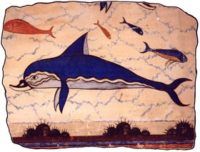Plasterboard - dolphin from Knossos
Plasterboard with motif "dolphin" approx. 17 x 22 x 1.5 cm
Countless frescoes as well as vase paintings bear witness to the Minoans' connection with the sea.
Contents: A plaster plate, a template with borders, a painting or colouring instruction, a sheet of carbon paper. a short instruction.
| Aspiration scale: | Easy |
|---|---|
| Time Line: | 1,5 Hours |
The Minoans
They were the first advanced civilisation in Europe, their seafarers dominated the Mediterranean for centuries and their bull cult was the model for the legend of the Minotaur: The Bronze Age empire of the Minoans, named after the legendary king Minos, is still legendary today.
The Minoans built large palace complexes on Crete around 5,000 years ago, constructed roads and developed a script that is still undeciphered today. Their sphere of influence stretched from the Aegean islands to Cyprus and the coast of Asia Minor to Mesopotamia and Egypt. But as magnificent and archaeologically productive as Minoan palaces such as Knossos or Phaistos are, their builders still pose numerous riddles to researchers. The reason for the decline of the legendary Minoan empire is also not clearly understood.
Only pictures as witnesses
One factor to which the Minoans owed their rise and also their wealth was their fleet. The geographical position of Crete made the island an important hub in the eastern Mediterranean. For the Minoans, the sea and maritime trade were therefore the driving force behind their economic and cultural success story.
Even the Greeks were obviously impressed by the Minoan sea trade, as the records of the Greek historian Thucydides show: "Minos was the first of whom we know that he possessed a fleet that dominated what is now the Hellenic Sea ...", his records state.
But what did the fleet of the legendary King Minos look like? And was it really as influential as Thucydides describes it? If archaeologists want to answer this question, they face a problem. For reliable sources about Minoan seafaring hardly exist. Written records that provide information about types of ships, the ports or maritime trade are missing.
The only tangible evidence are the sparse remains of harbours on Crete and the countless images of harbours, ships and water creatures in Minoan imagery. For they are found almost everywhere: whether as carvings in clay bowls, engravings on tiny seals, colourful frescoes and simple clay models - the sheer frequency of these motifs makes it clear how closely the Minoans were connected with the sea.

